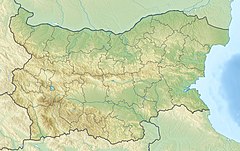Magura Cave
| Пещера Магурата | |

cave drawings in the Magura Cave
|
|
| Location | near Rabisha village, Belogradchik town, Belogradchik municipality |
|---|---|
| Region | Vidin Province, Bulgaria |
| Coordinates | 43°43′40″N 22°34′58″E / 43.72778°N 22.58278°ECoordinates: 43°43′40″N 22°34′58″E / 43.72778°N 22.58278°E |
The Magura Cave (Bulgarian: Пещера Магурата) (from Romanian magura, "hill") is located in north-western Bulgaria close to the village of Rabisha, 25 km (16 mi) from the town of Belogradchik in Vidin Province.
The prehistoric wall paintings of Magura have great resemblance with those of the Grotta dei Cervi in Italy, which are of exceptional expression and artistic depth and are considered the most significant works of art of the European Post-Paleolithic era.
Guided visits are conducted by the staff of Belogradchik municipality, to which the management of the cave was transferred in 2012 by the Bulgarian Council of Ministers.
In 1984 the site was induced into UNESCO's tentative list of World Heritage.
The total length of the 15 million year old cave is 2.5 km (1.6 mi). The average annual temperature of the cave is 12 °C (54 °F; 285 K), except for one room where the temperature is always 15 °C (59 °F; 288 K). The air humidity reaches 80% and the displacement - 56 m (184 ft). The Magura cave was formed in the limestone Rabisha Hill (461 m (1,512 ft) above sea level). The morphology of the cave consists of one main gallery with six various-sized halls and three lateral galleries around it. The main gallery is composed of six chambers, variously sized; the largest one, the so-called Arc Hall, is 128 m (420 ft) long, 58 m (190 ft) wide and 21 m (69 ft) high, including impressive natural vaults, speleothems, spectacular stalactites and stalagmites, named The Poplar, The Pipe Organ, The Oriental City and The Cactus. The very spacious site also allows for music concerts to be held during Christmas and Easter.
The inner temperature is constantly 11-12 °C. During the summers of 1974 and 1975 the cave was successfully used for speleotherapy and asthma treatment by Dr Vassil Dimitrov. Thirty patients slept in the cave for twelve consecutive nights, taking advantage of allergens absence, constant humidity and temperature.
...
Wikipedia

